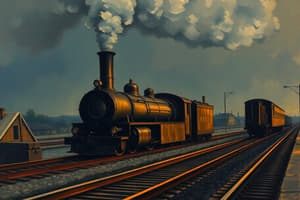Podcast
Questions and Answers
Who was responsible for creating the first system of time zones in the United States in 1883?
Who was responsible for creating the first system of time zones in the United States in 1883?
The railroad industry
How did railroads change and develop? (Select all that apply)
How did railroads change and develop? (Select all that apply)
- Railroads decreased the accessibility of raw materials
- Railroads became more versatile (correct)
- Rail travel became safer (correct)
- Americans began to measure time using time zones (correct)
How did railroads help make resources more available?
How did railroads help make resources more available?
By making it possible for natural resources to be transported to different cities and towns
What was the impact of the land grants given to railroads by the US government?
What was the impact of the land grants given to railroads by the US government?
What was a direct result of the expansion of the railroad networks?
What was a direct result of the expansion of the railroad networks?
What was a result of creating rail standardization?
What was a result of creating rail standardization?
Which development improved railroad safety?
Which development improved railroad safety?
Which invention was most important in revolutionizing the meat industry?
Which invention was most important in revolutionizing the meat industry?
During the Second Industrial Revolution, which building material became most important?
During the Second Industrial Revolution, which building material became most important?
Which invention improved safety for railway passengers?
Which invention improved safety for railway passengers?
Flashcards
Railroad Time Zones
Railroad Time Zones
A system established in 1883 to standardize time across the United States, improving scheduling and efficiency for rail travel.
Economic Impact of Railroads
Economic Impact of Railroads
Improved access to raw materials, stimulated manufacturing, facilitated the growth of new cities.
Railroads and Steel
Railroads and Steel
A major factor in the development of the steel industry, driven by the need for rails and infrastructure.
Standardized Rail Systems
Standardized Rail Systems
Signup and view all the flashcards
Air Brakes
Air Brakes
Signup and view all the flashcards
Refrigerator Car
Refrigerator Car
Signup and view all the flashcards
Steel
Steel
Signup and view all the flashcards
Government Land Grants
Government Land Grants
Signup and view all the flashcards
Study Notes
Railroad Industry and Time Zones
- The railroad industry established the first time zone system in the United States in 1883.
- Time zones improved scheduling and efficiency across the vast rail networks.
Evolution of Railroads
- Railroads evolved to become more versatile in operations and services provided.
- The introduction of time zones allowed Americans to standardize time for travel and communication.
- Safety improvements made rail travel a more secure mode of transportation.
Economic Impact of Railroads
- Railroads facilitated access to new raw materials, enhancing production and manufacturing capabilities.
- New cities emerged as manufacturing hubs, deriving growth from refined natural resources transported by rail.
- Trains necessitated materials for both construction and operation, further stimulating industrial growth.
Natural Resource Accessibility
- Railroad expansion made it easier to transport natural resources to various cities and towns, optimizing distribution.
Railroad and Economic Growth
- The growth of railroads contributed significantly to the U.S. economy by simplifying the transport of goods and resources.
Government Support for Railroads
- Land grants from the U.S. government to railroads spurred industrial growth in the West by promoting settlement and encouraging new ventures.
Steel Industry Growth
- Expansion of rail networks was a key factor in the development of the steel industry, which became pivotal for infrastructure projects.
Rail Standardization
- Creating standardized rail systems allowed trains from different lines to share tracks, enhancing interconnectivity.
Safety Innovations
- The replacement of hand-operated brakes with air brakes represented a major advancement in railroad safety.
Innovations in the Meat Industry
- The invention of the refrigerator car revolutionized the meat industry by enabling the transport of perishable goods without spoilage.
Steel as a Crucial Material
- During the Second Industrial Revolution, steel emerged as a fundamental building material essential to various industries and infrastructures.
Passenger Safety Improvements
- Safety for railway passengers was enhanced with the implementation of air brakes, ensuring a more reliable travel experience.
Studying That Suits You
Use AI to generate personalized quizzes and flashcards to suit your learning preferences.




